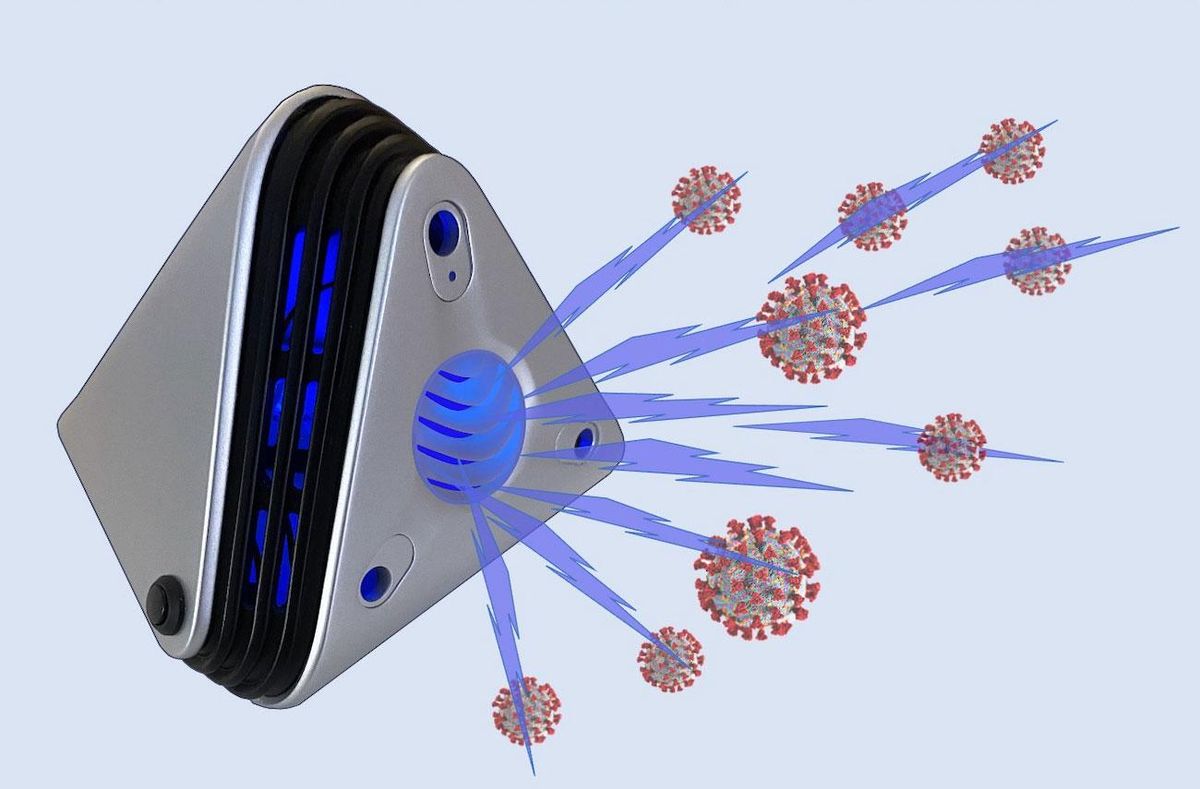Ultraviolet light became an important tool to fight the COVID-19 pandemic with virus-zapping UV robots plying hospitals and airports, and a plethora of personal UV gadgets to sanitize phones and keyboards. Those devices emit UV light at a wavelength of 254 nanometers, which destroys bacteria and viruses by wreaking havoc on their DNA or RNA. It can also penetrate human skin and eyes, causing skin cancer and cataracts.
Now researchers show that a type of shorter-wavelength UVC light, in the far-UV region, that is safe for people can kill 98 percent of microbes floating around in a room. As long as the lights were on, microbe levels remained low even as more were continually sprayed into the room. The study, published in Scientific Reports, suggest that far-UVC lamps could be an effective way to fight the spread of viral diseases like COVID and influenza. Getting there, though, will require new light sources, regulations, and increasing public awareness that far-UV light is safe.
“Widely installed far-UVC [light] could maybe prevent the next pandemic or the next yearly influenza epidemic.”
—David Brenner, Columbia University
“If the technology had been well developed five years earlier and far-UVC lights had been widely installed, potentially the COVID crisis could’ve been unlike what it has turned out to be,” says David Brenner, director of Columbia University’s Center for Radiological Research, and an author of the paper. “We’ve really lacked the tools to fight COVID. Masks, vaccination, and social distancing all involve people having to make decisions. Far-UVC is a passive device, it’s just up there in the ceiling.”
Humans have known for over a hundred years that UV radiation can kill deadly germs, and hospitals have used germicidal 254-nm UVC to sterilize objects for decades. But its harmful side effects on people mean the lamps can be turned on only when a room is empty, limiting effectiveness, Brenner says. “It’s not much use cleaning a room in the middle of the night, and then people walk in in the morning and start exhaling viruses in the air. You really need a way to clean the air in a room continually when people are around.”
This is where UV light with a shorter wavelength of 222 nm comes in. Its higher-energy light is strongly absorbed in the outer layers of human tissue. It does not get past the dead cells on the outer layer of skin or the tears that coat the eyes.
In 2020, Brenner and his team demonstrated that far-UVC light kills airborne coronaviruses. The study was done in a small chamber in the laboratory. For the new large-scale study, the researchers installed five commercial krypton chloride excimer far-UVC lamps in the ceiling of a ventilated room-sized enclosure. A mist of Staphylococcus aureus bacteria—which is slightly less sensitive to far-UVC than the coronavirus—was sprayed in on one side, while sensors measured their numbers at an air outlet on the other side.
Commercial far-UVC products came on the market right at the beginning of the pandemic, but “the availability of commercial products has outpaced the research,” says Ewan Eadie, a photobiologist at the University of Dundee school of medicine, in Scotland,” who led the latest research with Brenner. “Research needs to prove in what situation it works and how best to deploy it.”
What’s also needed are better sources for far-UVC light, says David Copithorne, vice president of marketing at startup NS Nanotech in Los Angeles, which is developing the world’s first solid-state source of far-UVC wavelengths. Krypton chloride excimer lamps, the only available source, “cost in the thousands of dollars, their lifetimes still are only several thousand hours, they run hot, they use caustic gases, and they are somewhat bulky.”
NS Nanotech’s far-UVC emitter based on a nitride semiconductor overcomes those issues, he says. The company is ramping up production and plans to ship its first product this year, intended for customers who want to purify their personal airspace in vehicles, offices, and airplanes.
Brenner and his colleagues’ groundbreaking work has put far-UVC in the spotlight, Copithorne adds. Regulatory bodies are now setting standards for its use in public spaces, and industry players are working hard to come up with appropriate ways to deploy far-UVC disinfection.
For Brenner, widespread use of far-UVC can’t come soon enough. Since the light is agnostic to the type of virus, and only cares about the genetic material inside, it should be able to kill any virus and its mutations effectively. “Widely installed far-UVC could maybe prevent the next pandemic or the next yearly influenza epidemic,” he says. “I would like to see it in all sorts of places where people get together and spend time—like offices, elevators, restaurants, bus stations, and airplanes.”
Prachi Patel is a freelance journalist based in Pittsburgh. She writes about energy, biotechnology, materials science, nanotechnology, and computing.



